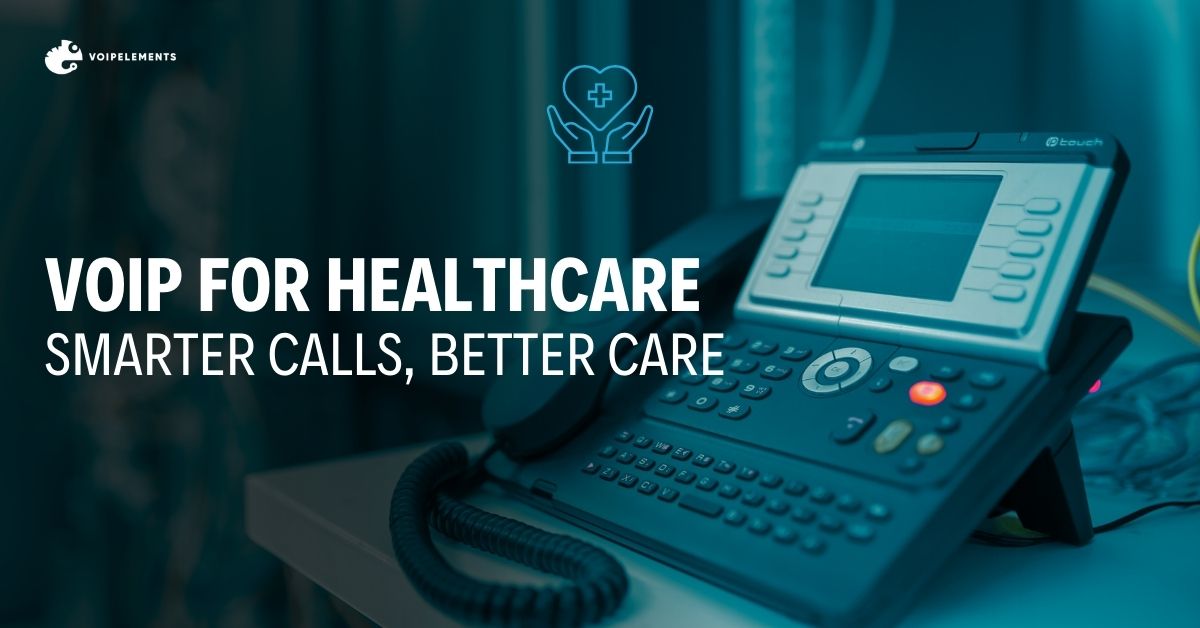One sector that has changed the most in recent years is healthcare. Numerous healthcare procedures are becoming more straightforward and efficient thanks to technology, which has also greatly enhanced patient experiences.
VoIP phone systems for healthcare fit nicely into this new era of digital transformation, which is why healthcare institutions are employing advanced billing systems, CRM, payment gateways, digital patient healthcare records, and other advanced technologies. It facilitates call routing based on caller ID and helps patient data sync with your CRM or healthcare records management system. It should come as no surprise that the VoIP industry is expected to develop at a 15% compound annual growth rate and reach a valuation of more than USD 95 billion between 2021 and 2027.
If you are thinking about implementing VoIP phone systems for healthcare, this article will go into great detail about why cloud phone systems for healthcare are the best course for this current wave of advancements in healthcare technology.
What Are VoIP Phone Systems for Healthcare?
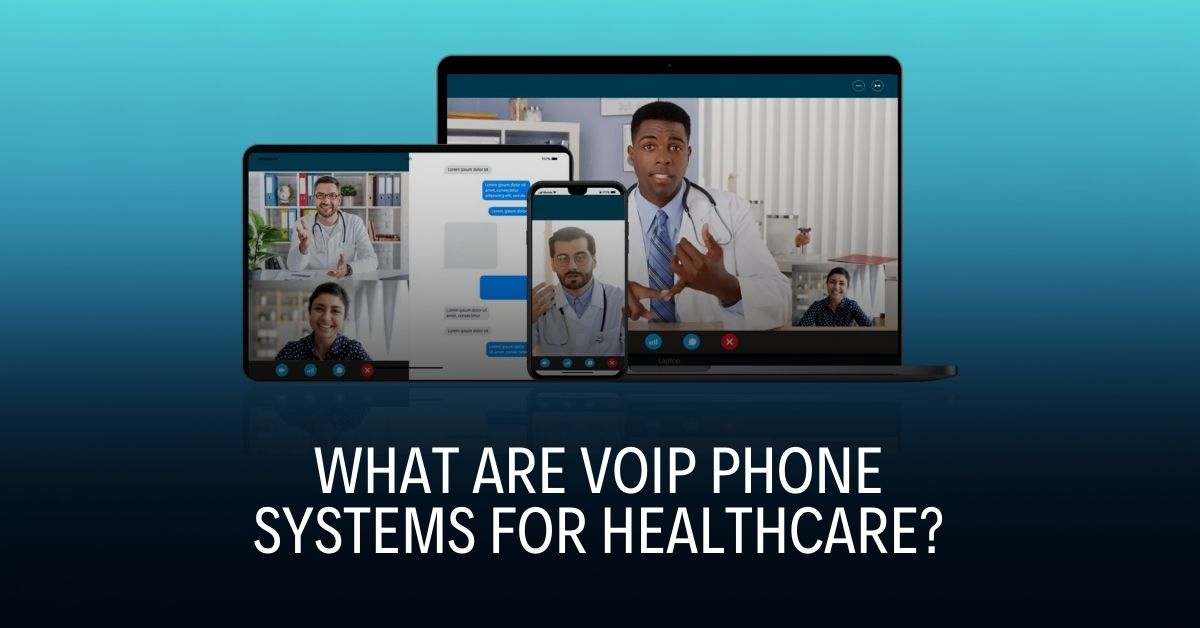
VoIP, which is an acronym for Voice Over Internet Protocol, is a digital phone system that uses an active Internet connection to create audio channels between users. VoIP phone systems do away with the requirement for traditional networks that rely on analog signals or physical landlines by using the internet. It makes it incredibly effective and simple to use.
VoIP phone systems for healthcare fit nicely into this new era of digital transformation, which is why healthcare institutions are employing advanced billing systems, CRM, payment gateways, digital patient healthcare records, and other advanced technologies. It facilitates call routing based on caller ID and helps patient data sync with your CRM or healthcare records management system.
It can also be used to set up appointments, generate reminders, integrate with billing, and offer the caller’s history, all of which can greatly enhance the efficiency of the interactions between your medical personnel and patients.
Implementation Considerations for Healthcare Providers
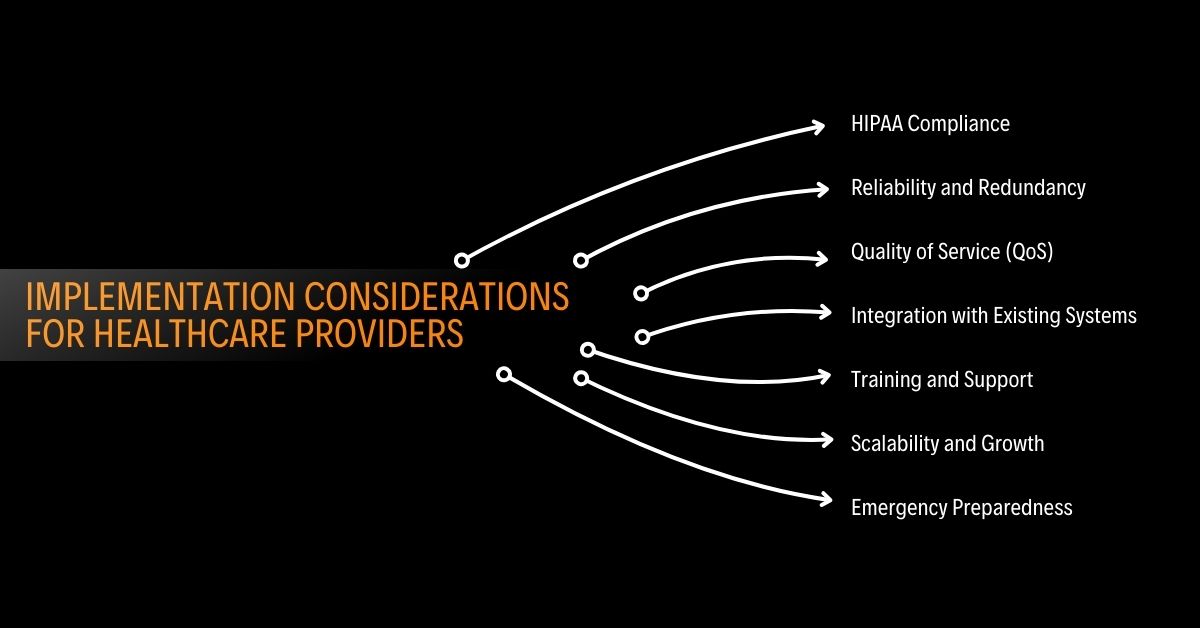
When implementing VoIP phone systems in healthcare settings, several key considerations should be taken into account to ensure a smooth transition and optimal performance:
- HIPAA Compliance: Make sure the VoIP provider you choose has HIPAA-compliant features like access controls, secure data storage, and end-to-end encryption to safeguard private patient information.
- Reliability and Redundancy: Continuous communication is essential to the functioning of healthcare facilities. To reduce the chance of service interruptions, pick a VoIP operator that provides redundancy measures and strong uptime guarantees. Replicated data centers, failover routing, and backup power sources can all aid in preserving connectivity in an emergency.
- Quality of Service (QoS): In healthcare communications, voice quality is crucial since patient care can be impacted by accuracy and clarity. Give preference to VoIP service providers that provide QoS capabilities in order to reduce latency, give voice traffic priority over data, and guarantee constant call quality even during periods of high usage.
- Integration with Existing Systems: Workflow efficiency depends on a smooth interface with the current IT infrastructure, which includes practice management software and electronic health record (EHR) systems. Select a VoIP solution that lets you customize it using APIs or middleware and has strong integration capabilities.
- Training and Support: Complete training and continuous technical assistance are essential for VoIP deployment success. Make sure healthcare personnel are properly trained to use the new system and troubleshoot typical problems. Furthermore, give preference to VoIP service providers who provide prompt customer service and resources specifically designed for the healthcare sector.
- Scalability and Growth: Healthcare companies should use VoIP solutions that are scalable to meet their changing needs and future expansion. Think about things like the flexibility to add more users and locations, update functionality as needed, and modify capacity to accommodate fluctuating demand.
- Emergency Preparedness: To guarantee continuity of care during emergencies, healthcare professionals need to have strong emergency communication protocols in place. Select VoIP systems with features like mass notification capabilities to notify staff members of emergencies, location-based routing, and emergency routing.
Security and Compliance Considerations for VoIP in Healthcare
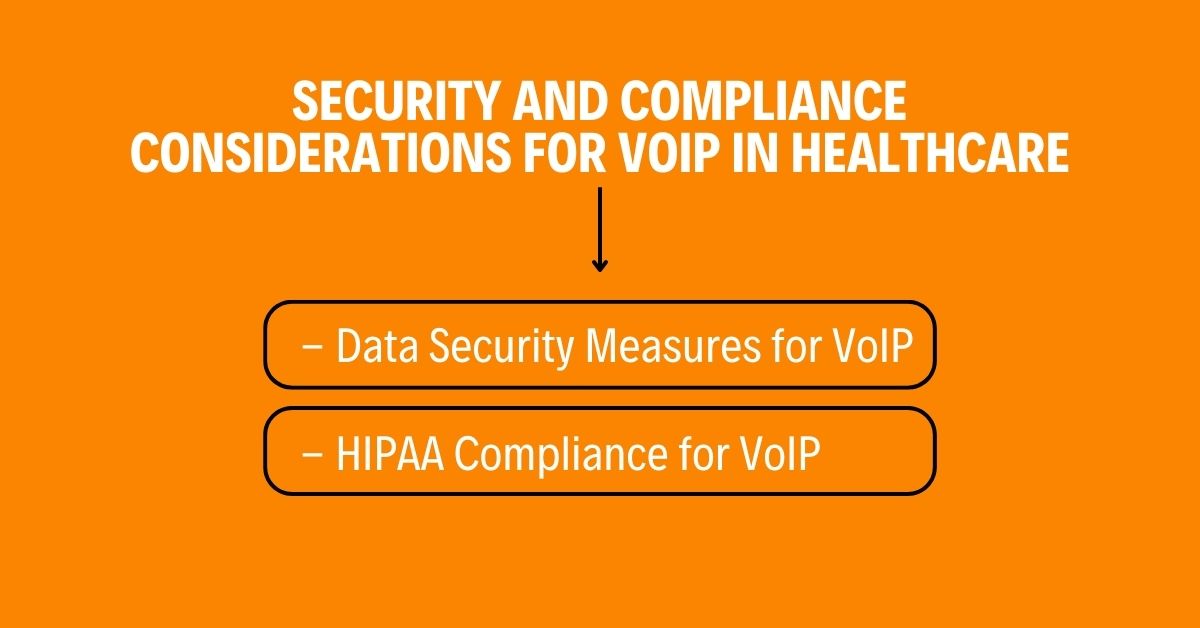
When installing VoIP phone systems in healthcare settings, security and compliance are critical considerations. Here are some crucial things to remember:
HIPAA Compliance for VoIP:
VoIP calls should be encrypted in order to safeguard patient confidentiality while it is being transmitted. To encrypt speech data, use protocols such as Transport Layer Security (TLS) or Secure Real-time Transport Protocol (SRTP).
- Access Controls: Put strong access controls in place to prevent unwanted access to VoIP systems and patient information. Limit rights depending on user roles by requiring multi-factor authentication, strong passwords, and role-based access control (RBAC).
- Audit Trails: Keep thorough records of all VoIP activities, including call logs, user access, and configuration modifications. These logs can be used to monitor and look into security events or violations of compliance.
- Business Associate Agreements (BAAs): Ensure that VoIP providers sign BAAs to legally bind them to HIPAA regulations and protect patient confidentiality. BAAs outline the responsibilities of both parties in safeguarding protected health information (PHI).
- Risk Assessments: Conduct regular risk assessments to identify vulnerabilities in VoIP systems and mitigate potential security risks. Assessments should evaluate threats such as eavesdropping, call interception, and unauthorized access.
Data Security Measures for VoIP:
- Secure Network Infrastructure: Implement firewalls, intrusion detection/prevention systems (IDS/IPS), and network segmentation to protect VoIP infrastructure from unauthorized access and cyber threats.
- Regular Software Updates: Keep VoIP software and firmware up to date with security patches and updates to address known vulnerabilities and reduce the risk of exploitation.
- Secure Configuration: Configure VoIP systems securely, following best practices such as disabling unused services, limiting access to administrative interfaces, and implementing secure password policies.
- Secure VoIP Endpoints: Secure VoIP endpoints such as IP phones and softphones with strong authentication mechanisms, encryption, and physical security measures to prevent unauthorized access and tampering.
- Data Encryption: Encrypt stored VoIP data, including call recordings, voicemails, and call logs, to protect sensitive information at rest. Use strong encryption algorithms and key management practices to ensure data confidentiality.
- Incident Response Plan: Develop and regularly test an incident response plan to effectively respond to security breaches, data breaches, or other cybersecurity incidents involving VoIP systems. The plan should include procedures for containment, investigation, notification, and recovery.
By addressing these security and compliance considerations, healthcare organizations can mitigate risks and ensure the confidentiality, integrity, and availability of VoIP communications while complying with HIPAA regulations and safeguarding patient data.
How Do VoIP Solutions Increase Productivity in Healthcare?
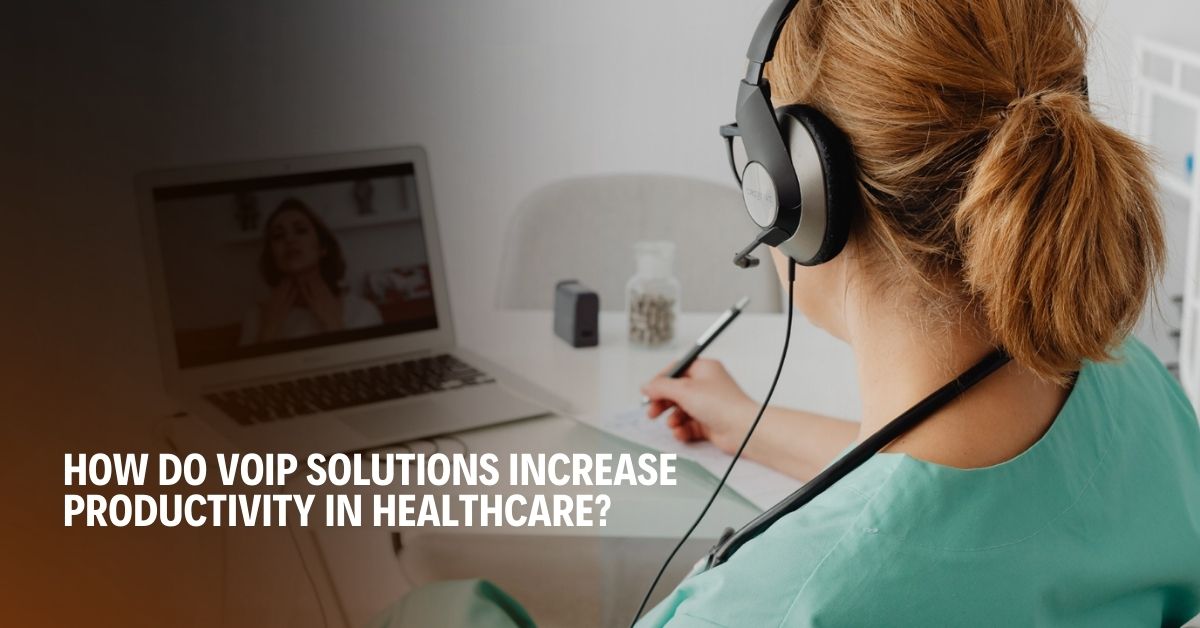
VoIP (Voice over Internet Protocol) solutions offer several features and benefits that can significantly increase productivity in healthcare settings:
- Streamlined Communication: VoIP enables seamless communication between healthcare professionals, patients, and administrative staff through various channels such as audio calls, video calls, instant messaging, and conferencing. This facilitates faster decision-making, collaboration on patient care, and coordination of tasks across departments.
- Remote Accessibility: With VoIP, healthcare workers can access communication tools from anywhere with an internet connection, allowing for remote consultations, telemedicine appointments, and on-the-go communication. This flexibility reduces the need for in-person meetings and enables healthcare professionals to provide timely care regardless of location.
- Integration with Electronic Health Records (EHR): Many VoIP solutions integrate seamlessly with electronic health record (EHR) systems, enabling practitioners to access patient information during calls. This integration streamlines workflows by eliminating the need to switch between different applications, saving time and reducing errors in documentation.
- Automated Appointment Reminders: VoIP systems can automate appointment reminders through voice calls, SMS, or email, reducing no-show rates and optimizing appointment scheduling. This frees up administrative staff from manual reminder tasks and ensures that appointment slots are utilized efficiently.
- Call Routing and Management: VoIP solutions offer advanced call routing and management features, such as intelligent call routing based on caller ID or patient information, call queuing, and call forwarding. This ensures that incoming calls are directed to the appropriate healthcare professional or department, reducing wait times and improving response times.
- Unified Communications: VoIP often comes bundled with unified communications (UC) features, including email integration, presence indicators, and collaboration tools like screen sharing and file sharing. These tools facilitate real-time communication and information sharing, enhancing teamwork and productivity among healthcare teams.
- Cost Savings: VoIP solutions typically offer cost savings compared to traditional phone systems, with lower hardware costs, reduced maintenance expenses, and affordable long-distance calling rates. By consolidating communication services into a single platform, healthcare organizations can achieve significant cost efficiencies while improving productivity.
How Does VoIP Analytics & Reporting Help Healthcare?
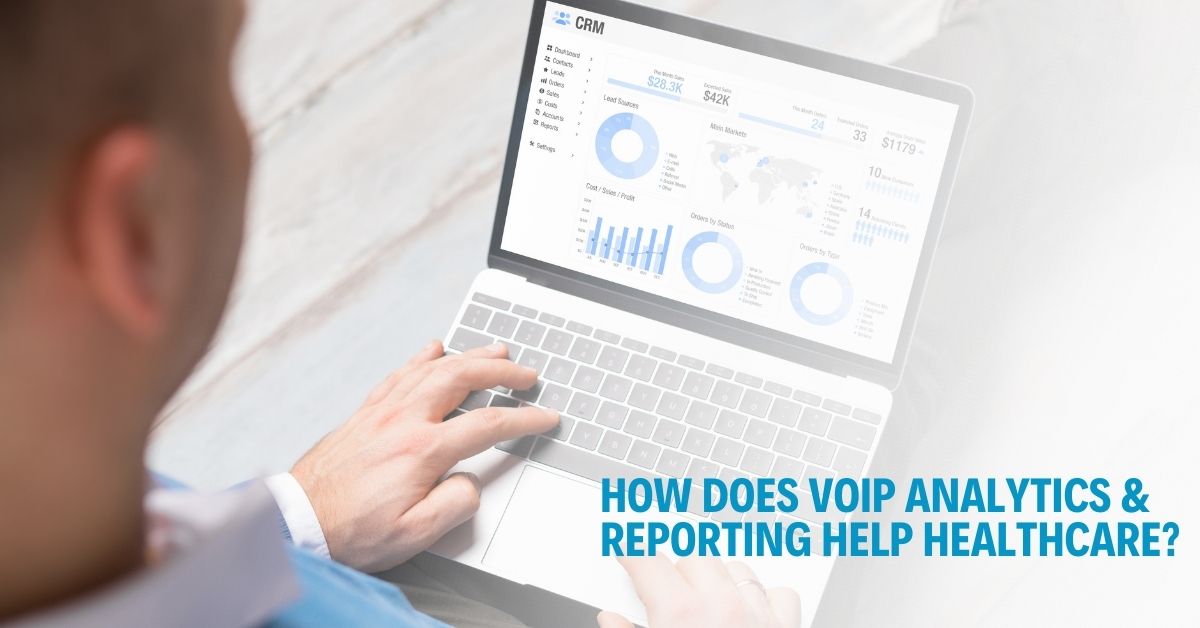
VoIP analytics and reporting play a crucial role in enhancing healthcare practices and improving patient experiences. By leveraging data insights from VoIP phone systems, healthcare providers can optimize communication, streamline workflows, and ultimately deliver better care. Here’s how VoIP analytics and reporting benefit the healthcare industry:
- Optimizing Call Routing: VoIP analytics provide valuable insights into call patterns, including peak call times, call volume by department, and common reasons for calls. By analyzing this data, healthcare organizations can optimize call routing to ensure that incoming calls are directed to the most appropriate healthcare professional or department, reducing wait times and improving efficiency.
- Improving Patient Satisfaction: VoIP analytics help healthcare providers understand patient communication preferences and identify areas for improvement in patient interactions. By tracking metrics such as call resolution times, hold times, and call abandonment rates, organizations can identify bottlenecks in the communication process and implement strategies to enhance patient satisfaction.
- Enhancing Staff Productivity: VoIP reporting tools provide insights into staff performance and call handling efficiency. Healthcare managers can use these reports to identify training needs, monitor staff availability, and ensure that calls are being handled promptly and effectively. By optimizing staff workflows and communication processes, organizations can improve productivity and reduce the time and money spent on inefficient practices.
- Ensuring Compliance: VoIP analytics can help healthcare organizations monitor and enforce compliance with regulatory requirements, such as HIPAA (Health Insurance Portability and Accountability Act). By tracking call recording and access to patient data, organizations can ensure that sensitive information is handled securely and that all communication practices adhere to industry regulations.
- Identifying Trends and Patterns: VoIP analytics enable healthcare providers to identify trends and patterns in patient communication, such as common reasons for calls, frequently asked questions and patient preferences for communication channels. By understanding these trends, organizations can tailor their communication strategies to better meet patient needs and preferences, ultimately improving the patient experience.
Getting Started with VoIP for Healthcare

Getting started with VoIP for healthcare involves several key steps to ensure a smooth implementation and maximize the benefits for both healthcare providers and patients.
Assess Your Communication Needs: Begin by evaluating your current communication infrastructure and identifying areas for improvement. Consider factors such as the volume of incoming calls, the need for remote access and mobility, integration with electronic health records (EHR) systems, and compliance requirements such as HIPAA.
Choose the Right VoIP Provider: Select a reputable VoIP provider with experience serving the healthcare industry. Look for providers that offer HIPAA-compliant solutions, robust security features, reliable uptime, and scalability to accommodate your organization’s needs as it grows.
Conduct a Network Readiness Assessment: Before implementing VoIP, assess your network infrastructure to ensure it can support the additional bandwidth requirements of VoIP traffic. Evaluate factors such as network capacity, quality of service (QoS) settings, and potential bottlenecks that could affect call quality and reliability.
Select VoIP Features and Functionality: Determine which VoIP features are essential for your healthcare organization. Common features include call routing and management, voicemail-to-email transcription, video conferencing, integration with EHR systems, and encryption for secure communication.
Develop a Deployment Plan: Create a deployment plan that outlines the steps for migrating to VoIP, including installation, configuration, testing, and training. Assign responsibilities to key stakeholders and establish timelines for each phase of the deployment process.
Implement Security Measures: Prioritize security when implementing VoIP for healthcare. Implement encryption for voice traffic, secure user authentication mechanisms, access controls, and regular security updates to protect against cyber threats and ensure compliance with HIPAA regulations.
Monitor Performance and Usage: Once VoIP is deployed, monitor the performance and usage of the system to identify any issues or areas for optimization. Track metrics such as call volume, call quality, response times, and user satisfaction to continuously improve the VoIP experience for both staff and patients.
Provide Ongoing Support: Offer ongoing technical support and assistance to healthcare staff to address any issues or concerns that arise with the VoIP system. Establish channels for reporting problems, provide troubleshooting resources, and stay proactive in addressing user needs and feedback.
Wrapping Up
In the fast-paced healthcare industry, where every second matters, communication is essential. There are fresh hurdles every day, ranging from dealing with patients to communicating with coworkers and mobile workers. Conventional phone systems frequently cause needless delays to these crucial operations, costing money in terms of both time and resources. VoIP, on the other hand, provides a quick and easy alternative that allows you to quickly connect to everyone you need to reach.
VoIP streamlines communication procedures, which saves money and time and frees up resources for medical personnel to use more effectively—improving patient care. VoIP wins out when given the option to choose between the two, making it easier and more efficient for healthcare professionals to carry out their demanding jobs.

